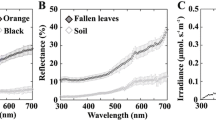Abstract
The dwarf morph of Telmatochromis temporalis uses empty snail shells as shelters and spawning sites. This morph varies in body colour from pale to dark within populations. Pale individuals are likely to be cryptic on sandy-brown backgrounds through colour matching, but adaptive significance of dark individuals is unknown. The present study proposes two hypotheses for the occurrence of dark individuals: crypsis in darkness inside shells (darkness matching) and crypsis in irregular patterns consisting of shell shadows on sandy-brown backgrounds (pattern matching). The former hypothesis is less likely to be the main factor evolving dark bodies, because body darkness was not correlated with the amount of time that the fish remained within shells. Body darkness was correlated with shell density in their habitats, supporting the latter hypothesis because dark individuals may be able to mingle with shell shadows effectively at sites where shells were abundant. This study also found that body darkness was environmentally induced; therefore, this fish may shift between these anti-predator tactics (crypsis of pale individuals on sandy-brown backgrounds through colour matching and crypsis of dark individuals in irregular shadow patterns through pattern matching) by changing body darkness in response to shell density.




Similar content being viewed by others
References
Cal, L., P. Suarez-Bregua, J. M. Cerdá-Reverter, I. Braasch & J. Rotllant, 2017. Fish pigmentation and the melanocortin system. Comparative Biochemistry and Physiology Part A 211: 26–33.
Endler, J. A., 1991. Interactions between predators and prey. In Krebs, J. R. & N. B. Davies (eds), Behavioural Ecology: An Evolutionary Approach, 3rd ed. Blackwell Scientific Publications, Oxford: 169–196.
Hori, M., 1997. Structure of littoral fish communities organized by their feeding activities. In Kawanabe, H., M. Hori & M. Nagoshi (eds), Fish Communities in Lake Tanganyika. Kyoto University Press, Kyoto: 275–298.
Hori, M., M. M. Gashagaza, M. Nshombo & H. Kawanabe, 1993. Littoral fish communities in Lake Tanganyika: irreplaceable diversity supported by intricate interactions among species. Conservation Biology 7: 657–666.
Kohda, M. & M. Hori, 1993. Dichromatism in relation to the trophic biology of predatory cichlid fishes in Lake Tanganyika, East Africa. Journal of Zoology 229: 447–455.
Kohda, M., M. Hori & M. Nshombo, 1997. Inter-individual variation in foraging behaiour and dimorphism in predatory cichlid fishes. In Kawanabe, H., M. Hori & M. Nagoshi (eds), Fish Communities in Lake Tanganyika. Kyoto University Press, Kyoto: 121–136.
Mboko, S. K. & M. Kohda, 1995. Pale and dark dichromatism related to microhabitats in a herbivorous Tanganyikan cichlid fish, Telmatochromis temporalis. Journal of Ethology 13: 77–83.
Nosil, P., 2012. Ecological Speciation. Oxford University Press, Oxford.
Nshombo, M., 1994. Polychromatism of the scale-eater Perissodus microlepis (Cichlidae, Teleostei) in relation to foraging behavior. Journal of Ethology 12: 141–161.
Pener, M. P. & S. J. Simpson, 2009. Locust phase polyphenism: an update. Advances in Insect Physiology 36: 1–272.
Stevens, M. & S. Merilaita, 2009. Animal camouflage: current issues and new perspectives. Philosophical Transactions of the Royal Society B 364: 423–427.
Takahashi, T., 2004. Morphological and genetic distinctness of rock and shell-bed dwelling Telmatochromis (Teleostei, Cichlidae) in the south of Lake Tanganyika suggest the existence of two species. Journal of Fish Biology 65: 419–435.
Takahashi, T., 2010. Different degrees of lunar synchronization of ovary development between two morphs of a Tanganyikan cichlid fish. Hydrobiologia 644: 139–143.
Takahashi, T. & K. Ota, 2016. Body size evolution of a shell-brooding cichlid fish from Lake Tanganyika. Journal of Evolutionary Biology 29: 2373–2382.
Takahashi, T., K. Watanabe, H. Munehara, L. Rüber & M. Hori, 2009. Evidence for divergent natural selection of a Lake Tanganyika cichlid inferred from repeated radiations in body size. Molecular Ecology 18: 3110–3119.
Takahashi, T., K. Ota, M. Kohda & M. Hori, 2012. Some evidence for different ecological pressures that constrain male and female body size. Hydrobiologia 664: 35–44.
Yamamoto, K., Y. Tsujimura, M. Kometani, C. Kitazawa, A. T. Islam & A. Yamanaka, 2011. Diapause pupal color diphenism induced by temperature and humidity conditions in Byasa alcinous (Lepidoptera: Papilionidae). Journal of Insect Physiology 57: 930–934.
Yanagisawa, Y., M. Nshombo, M. Nishida & Y. Niimura, 1990. Sexual dichromatism and feeding habits of the scale-eater Plecodus straeleni (Cichlidae, Teleostei) in Lake Tanganyika. Journal of Ethology 8: 25–28.
Winkelmann, K., M. J. Genner, T. Takahashi & L. Rüber, 2014. Competition-driven speciation in cichlid fish. Nature Communications 5: 3412.
Acknowledgements
I thank H. Phiri, M. Mbewe, D. Sinynza, T. Banda, L. Makasa, and other staff at the Lake Tanganyika Research Unit in Mpulungu for support in the field. I am also grateful to M. Hori, M. Kohda, and C. Sturmbauer for the loan of field research equipment, B. Kapembwa, K. Symkanz, B. Kasikira, and F. Chinyama for field assistance, R. Sakurai for advice on the manuscript, and the editor in charge, C. Sefc, and two anonymous reviewers for their valuable comments on earlier version of this manuscript. This study was partly supported by Grants-in-Aid for Scientific Research (B) (Nos. 26291078 and 18H02499) from the Ministry of Education, Culture, Sports, Science and Technology (MEXT), Japan.
Author information
Authors and Affiliations
Corresponding author
Additional information
Guest editors: S. Koblmüller, R. C. Albertson, M. J. Genner, K. M. Sefc & T. Takahashi / Advances in Cichlid Research III: Behavior, Ecology and Evolutionary Biology
Rights and permissions
About this article
Cite this article
Takahashi, T. Colour variation of a shell-brooding cichlid fish from Lake Tanganyika. Hydrobiologia 832, 193–200 (2019). https://doi.org/10.1007/s10750-018-3717-6
Received:
Revised:
Accepted:
Published:
Issue Date:
DOI: https://doi.org/10.1007/s10750-018-3717-6




